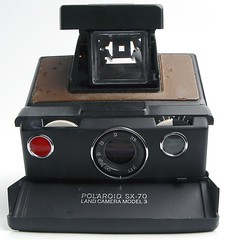Polaroid
The Polaroid Corporation was founded in 1937 by Edwin H. Land. It is most famous for its instant film cameras, which reached the market in 1948, and continue to be the company's flagship product line. The company's original dominant market was in polarized sunglasses, an outgrowth of Land's self-guided research in polarization after leaving Harvard University at the age of 17 (he later returned to Harvard to continue his research).
After Polaroid defeated Kodak in a patent battle, Kodak left the instant camera business on January 9, 1986.
Early instant cameras were often referred to and titled as "Land Cameras," named after the inventor of the instant process, Dr. Land. Instant cameras have been produced to use three main categories of film: rollfilm, packfilm, and integral film. All of these films can be expensive, usually costing about $1 per shot, or print. Through its history, Polaroid has been known as a company that builds quirky cameras cheaply that work quite well. Most Polaroid cameras have fully automatic exposure systems, with an electric eye to determine correct exposure. Quality can range from extremely good, as in the Pathfinder or SX-70 cameras, to extremely poor, as in the JoyCam. Despite its history of innovation, the company entered the digital photography market very late in the game, and as a result has neither a significant market share nor significant innovation in this area.
The company filed for federal bankruptcy protection in October 11, 2001, and most of the business was thereafter carried on by the Polaroid Holding Company (PHC), managed by Bank One. Significant criticism surrounded this takeover because the process left executives of the company with large bonuses, while stockholders, as well as current and retired employees, were left with nothing. Polaroid's bankruptcy was widely believed to be the result of the failure of its senior management to see the effect of digital cameras on its film business, a fate that also befell its primary rival, Kodak. Since the bankruptcy Polaroid branded LCD and Plasma televisions and portable DVD players have appeared on the market.
On April 27, 2005, Petters Group Worldwide announced its acquisition of PHC. Petters has in the past bought up failed companies with well-known names for the value of those names. The same year, Flextronics purchased Polaroid's manufacturing operations and the decision was made to send most of the manufacturing to China.
Contents
Types of Polaroid Instant Cameras
Instant Rollfilm
- Polaroid Pathfinder
- Polaroid Highlander
- Polaroid Swinger
Instant Packfilm
Polaroid produced various model lines of cameras to use the peel-apart 80 or 100 series packfilm. Currently only 100 series film is still in production, and there are several variants of the film to suit most purposes.
Folding Cameras - Series 1 (Mid 60's - Mid 70's)
'Bellows'-type models which fold down into a solid body, with a flip-up cover to fold over the lens assembly. All these models feature rangefinder style focus mechanisms, and some of the more expensive models include Zeiss Ikon-produced rangefinders. The shutter must be manually cocked after every release of the shutter before another photograph can be taken. All cameras in this series use 100 series film. Examples:
- Polaroid 100-400 series
- Polaroid Land Model 103
- Polaroid Land Model 220
- Polaroid Land Model 350
- Polaroid Land Model 430
Folding Cameras - Series 2 (Late 70's - Early 00's)
Rigid, self erecting bellows-type cameras where the base of the bellow structure becomes the cover for the camera when folded. These models do not feature rangefinders at all, instead they all rely on distance scale focusing by turning the front lens element. These cameras can all take either 100 or 80 series film; the fixed viewfinders feature guides for each format. Examples:
Non-Folding Consumer Models (Late 60's - Mid 70's)
Fixed plastic body cameras, most have front lens element distance scale focusing, though some are fixed focus. Most models usse 100 series packfilm, a few use 80 series, and some are able to use both. Many models exist in this series; often they are very similar and were simply renamed for different markets. Examples:
Non-Folding Professional models (Late 70's - 90's)
Professional, metal bodied cameras with very high build quality and excellent optics.
Examples:
Other
There are several exchangeable backs for 35mm, medium and large format film cameras that utilise peel-apart packfilm as well. Not many of these were made by Polaroid themselves. They are often used to take 'preview' shots on photo shoots, though Polaroid fans can use them as high-quality manually set Polaroid cameras with interchangeable optics.
Instant Integral film
There were three main types of integral film produced by Polaroid: SX-70, 600 and Spectra film. All follow the same basic design: the film packs contain batteries which power the camera's exposure meter and automatically eject the pictures on shutter release.
SX-70 and 600 film are identical in size - both produce square prints of 79mm x 79mm with the familiar 'Polaroid border' around the image. Many users of cameras designed for SX-70 film today use 600 film instead as SX-70 film is no longer available. Certain measures must be taken to prevent overexposure if 600 film is used in SX-70 cameras as 600 film has a speed equal to ISO 600; SX-70 develops at ISO 150.
Spectra film is slightly larger and rectangular in format: the image produced is 92mm x 73mm. Like 600 film, Spectra has a speed of ISO 600. Spectra is known as Image film in some markets. Examples:
- Polaroid SX-70
- Polaroid SX-70 Model 3
- Polaroid Job Pro
- Polaroid One Step
- Polaroid Sun 660
- Polaroid Spectra
Other types of instant film
- Polaroid i-zone
- Polaroid MIO
- Polaroid JoyCam
- Polaroid Pop Shots







